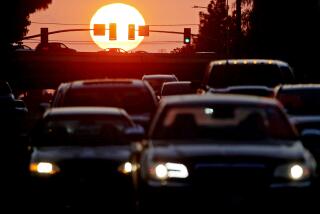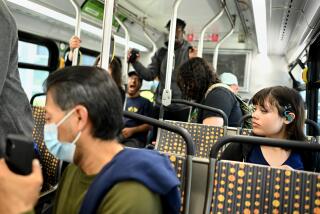Commute Time: It’s Come a Long Way
- Share via
WASHINGTON — It has been suggested that controlled congestion is the mark of a civilized society. If so, this nation’s mounting traffic gridlocks and snarls could produce a commuting anarchy/amorality within the next decade.
If the price of traffic congestion exceeds a level of tolerance, transportation specialist Robert Dunphy of the Urban Land Institute, insists optimistically that the public will probably become sufficiently resolved to bring the problem under control. But, Dunphy added, almost ominously: “On the other hand, the cost of establishing completely free-flowing streets during peak hours will likely remain too expensive for any area.”
Dunphy recently wrote that surveys have shown that transportation problems are the most important concern of residents of Phoenix, Washington, Atlanta and Houston. (And most other major cities would show similar concerns if they were surveyed.) Furthermore, a recent conference of the Institute of Transportation Engineers pinpointed traffic congestion as a “growing national problem.”
In appraising the nation’s urban traffic congestion, a ULI survey of Houston, Denver and Seattle banks, business services and law firms found that proximity to employee residences and the avoidance of traffic and parking problems were far more significant to suburban businesses than to downtown counterparts.
Southern California residents need no statistics to make them aware of traffic congestion problems. However, they might feel even sorrier for themselves to learn that the 1980 census showed the average travel time reported by all commuters living in urban areas was only 22.5 minutes. But for suburban residents across the nation, commuting to an urban central business district required an average 35 minutes. And persons living and working outside such a district spent only 19 minutes commuting to jobs.
The most shocking of the outdated 1980 figures on commuting habits of 7 million Americans showed that 12% of those residing in urban areas needed more than 45 minutes to get to their jobs each day. In Seattle, the average 1980 commuting time was the same as the national average--22 minutes--but that figure is expected to climb to 34 minutes (an increase of more than 50%) by 1990, “even after the completion of substantial planned transportation improvements,” Dunphy reported in the October edition of Urban Land magazine.
Are there any signs of that traffic congestion being ameliorated? Here are a few rays of hope, listed briefly:
1--More public funding of roads, i.e. the new higher fuel tax.
2--Transit improvements. The new metro rapid transit helped here in the nation’s capital and also in Atlanta and San Francisco. Even auto-dominated Los Angeles, Houston and Dallas are considering new urban rail systems, Dunphy reported.
3--Ride-sharing is helping. Two major new roads here in Washington require a minimum of four passengers during rush hours. The economics of auto commuting have also caused many federal workers to share rides, and they now meet at publicly built park-and-ride lots. But documentation is scant on how much ride-sharing has increased since 1980, when 78% of auto commuters rode alone.
4--Flexible work hours. More companies and government agencies now adjust their working hours for employees to permit off-peak-hour commuting.
5--A new-home sales executive in the Washington area noted that few buyers now inquire about the commuting time into downtown because most of them are shopping for houses near their jobs in suburban areas with big commercial complexes.
Finally, ULI’s Dunphy also strikes a positive note by suggesting that “telecommuting” may permit more Americans to work at home one or more days a week, using small computers and communications links. If more employed persons work in their homes and make fewer trips to their employment bases, traffic congestion could be markedly reduced in peak hours. Also, household location patterns could change to enable more employees to live farther from their employment base and thus commute longer distances fewer times.
More to Read
Sign up for Essential California
The most important California stories and recommendations in your inbox every morning.
You may occasionally receive promotional content from the Los Angeles Times.










